| |||||
| Decades: | |||||
|---|---|---|---|---|---|
| See also: | |||||
This article lists events that occurred during 1990 in Estonia .
| |||||
| Decades: | |||||
|---|---|---|---|---|---|
| See also: | |||||
This article lists events that occurred during 1990 in Estonia .
| | This section is empty. You can help by adding to it. (December 2020) |
| | This section is empty. You can help by adding to it. (December 2020) |

The Singing Revolution was a series of events in 1987–1991 that led to the restoration of independence of the three then Soviet-occupied Baltic countries of Estonia, Latvia, and Lithuania at the end of the Cold War. The term was coined by an Estonian activist and artist, Heinz Valk, in an article published a week after the 10–11 June 1988 spontaneous mass evening singing demonstrations at the Tallinn Song Festival Grounds.
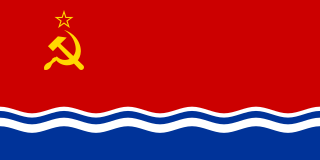
The Latvian Soviet Socialist Republic, also known as Soviet Latvia or simply Latvia, was a republic in the Soviet Union. The Latvian SSR existed for over 50 years, from 5 August 1940 to 6 September 1991.
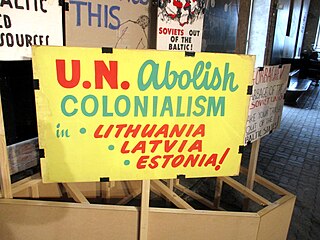
The three independent Baltic countries – Estonia, Latvia, and Lithuania – were invaded and occupied in June 1940 by the Soviet Union, under the leadership of Stalin and auspices of the Molotov–Ribbentrop Pact that had been signed between Nazi Germany and the Soviet Union in August 1939, immediately before the outbreak of World War II. The three countries were then annexed into the Soviet Union in August 1940. The United States and most other Western countries never recognised this incorporation, considering it illegal. On 22 June 1941, Nazi Germany attacked the Soviet Union and within weeks occupied the Baltic territories. In July 1941, the Third Reich incorporated the Baltic territory into its Reichskommissariat Ostland. As a result of the Red Army's Baltic Offensive of 1944, the Soviet Union recaptured most of the Baltic states and trapped the remaining German forces in the Courland Pocket until their formal surrender in May 1945.
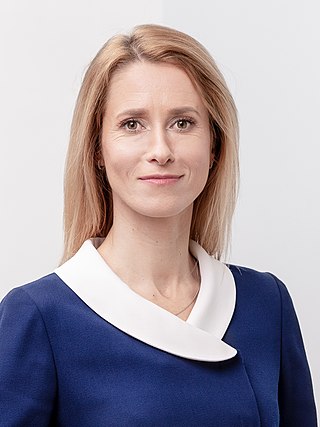
The prime minister of Estonia is the head of government of the Republic of Estonia. The prime minister is nominated by the president after appropriate consultations with the parliamentary factions and confirmed by the parliament (Riigikogu). In case of disagreement, the Parliament can reject the president's nomination and choose their own candidate. In practice, since the prime minister must maintain the confidence of Parliament in order to remain in office, they are usually the leader of the senior partner in the governing coalition. The current prime minister is Kaja Kallas of the Reform Party. She took the office on 26 January 2021 following the resignation of Jüri Ratas.

Black January, also known as Black Saturday or the January Massacre, was a violent crackdown on Azerbaijani nationalism and anti-Soviet sentiment in Baku on 19–20 January 1990, as part of a state of emergency during the dissolution of the Soviet Union.
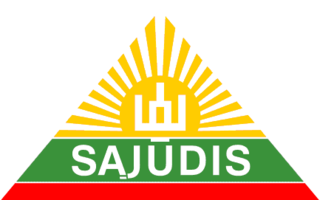
Sąjūdis, initially known as the Reform Movement of Lithuania, is a political organisation which led the struggle for Lithuanian independence in the late 1980s and early 1990s. It was established on 3 June 1988 as the first opposition party in Soviet Lithuania, and was led by Vytautas Landsbergis. Its goal was to seek the return of independent status for Lithuania.

The Baltic Way or Baltic Chain was a peaceful political demonstration that occurred on 23 August 1989. Approximately two million people joined their hands to form a human chain spanning 690 kilometres (430 mi) across the three Baltic states of Estonia, Latvia and Lithuania, which at the time were occupied and annexed by the USSR. The central government in Moscow considered the three Baltic countries constituent republics of the Soviet Union.

The Act of the Re-Establishment of the State of Lithuania or Act of March 11 was an independence declaration by Lithuania adopted on March 11, 1990, signed by all members of the Supreme Council of the Republic of Lithuania led by Sąjūdis. The act emphasized restoration and legal continuity of the interwar-period Lithuania, which was occupied by the Soviet Union and annexed in June 1940. In March, 1990, it was the first of the 15 Soviet republics to declare independence, with the rest following suit over the ensuing twenty-one months. These events led to the dissolution of the Soviet Union in December 1991.

The Declaration "On the Restoration of Independence of the Republic of Latvia" was adopted on 4 May 1990 by the Supreme Soviet of the Latvian SSR in which Latvia declared independence from the Soviet Union. The Declaration stated that, although Latvia had de facto lost its independence in 1940, when it was annexed by the Soviet Union, the country had de jure remained a sovereign country as the annexation had been unconstitutional and against the will of the Latvian people. It asserted the priority of the basics of the international law over the national laws and therefore it resolved that the Molotov–Ribbentrop Pact and the Soviet occupation of Latvia in 1940 were illegal. It also asserted that the heavily rigged 1940 elections were illegal and unconstitutional, and that all acts of the People's Saeima chosen at that election–including the request to join the Soviet Union on 21 July 1940–were ipso facto void.
The Estonian Sovereignty Declaration, fully: Declaration on the Sovereignty of the Estonian SSR, was issued on November 16, 1988 during the Singing Revolution in the Estonian SSR. The declaration asserted Estonia's sovereignty and the supremacy of the Estonian laws over the laws of the Soviet Union. Estonia's parliament also laid claim to the republic's natural resources: land, inland waters, forests, mineral deposits and to the means of industrial production, agriculture, construction, state banks, transportation, municipal services, etc. in the territory of Estonia's borders. November 16 is now celebrated annually as the "Day of Declaration of Sovereignty".

Parliamentary elections were held in the Latvian SSR on 18 March 1990. It was the first free parliamentary election in Latvia since 1931 and saw 201 deputies elected to the Supreme Soviet of the Latvian SSR, 170 of them in the first round. Run-off elections were held on 25 March, 1 April and 29 April. The Popular Front of Latvia won over two-thirds of the vote. Unlike its Estonian and Lithuanian counterparts, the Latvian Communist Party did not separate from the Communist Party of the Soviet Union. Nonetheless, on 3 May 1990, the new Supreme Soviet re-elected the Communist Party member Anatolijs Gorbunovs as its chairman, effectively the leader of Latvia. He subsequently resigned from the party, and a year later the Communist Party was banned by the parliament.
Elections to the Supreme Soviet were held in the Estonian SSR on 18 March 1990. Altogether 392 candidates ran for the Soviet-style legislature's 105 seats, of which four were pre-allocated to the military districts of the Soviet Army. The pro-independence Popular Front won the plurality. The coalition of the reformed Estonian communists, who favored independence but close relations with the USSR and were supported by Indrek Toome who was running under the Free Estonia banner, won 27 seats. The anti-independence, pro-Moscow "Joint Soviet of Work Collectives", representing mostly the ethnic Russian immigrant minority in Estonia, won 25 seats. During its first session, the new legislature elected the former Communist Party member Arnold Rüütel as its chairman, allowing him to stay as the nominal leader of Estonia.
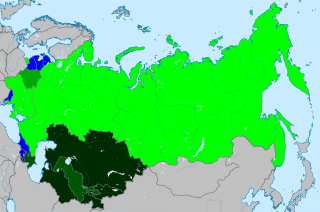
A referendum on the future of the Soviet Union was held on 17 March 1991 across the Soviet Union. It was the only national referendum in the history of the Soviet Union, although it was boycotted by authorities in six of the fifteen Soviet republics.

Relevant events began regarding the Baltic states and the Soviet Union when, following Bolshevist Russia's conflict with the Baltic states—Lithuania, Latvia and Estonia—several peace treaties were signed with Russia and its successor, the Soviet Union. In the late 1920s and early 1930s, the Soviet Union and all three Baltic States further signed non-aggression treaties. The Soviet Union also confirmed that it would adhere to the Kellogg–Briand Pact with regard to its neighbors, including Estonia and Latvia, and entered into a convention defining "aggression" that included all three Baltic countries.

The three Baltic states – Estonia, Latvia and Lithuania – were re-occupied in 1944–1945 by the Soviet Union (USSR) following the German occupation. The Baltic states regained independence in 1990–1991.

The dissolution of the Soviet Union was the process of internal disintegration within the Soviet Union (USSR), which resulted in the end of the existence of the country and of its federal government as a sovereign state, which in turn resulted in its 15 constituent republics gaining full independence on 26 December 1991. It brought an end to General Secretary Mikhail Gorbachev's effort to reform the Soviet political and economic system in an attempt to stop a period of political stalemate and economic backslide. The Soviet Union had experienced internal stagnation and ethnic separatism. Although highly centralized until its final years, the country was made up of 15 top-level republics that served as homelands for different ethnicities. By late 1991, amid a catastrophic political crisis, with several republics already departing the Union and the waning of centralized power, the leaders of three of its founding members declared that the Soviet Union no longer existed. Eight more republics joined their declaration shortly thereafter. Gorbachev resigned in December 1991 and what was left of the Soviet parliament voted to end itself.
Estonian Restoration of Independence, legally defined as the Restoration of the Republic of Estonia, was proclaimed on 20 August 1991. On that day at 23:02 local time, the Supreme Council of the Republic of Estonia, in agreement with the Estonian Committee, declared the illegal Soviet occupation and annexation of the country terminated, and proclaimed the full restoration of the independence of Estonia.
This article lists events that occurred during 1988 in Estonia.
This article lists events that occurred during 1989 in Estonia.

The Soviet economic blockade of Lithuania was imposed by the Soviet Union on Lithuania between 18 April and 2 July 1990.